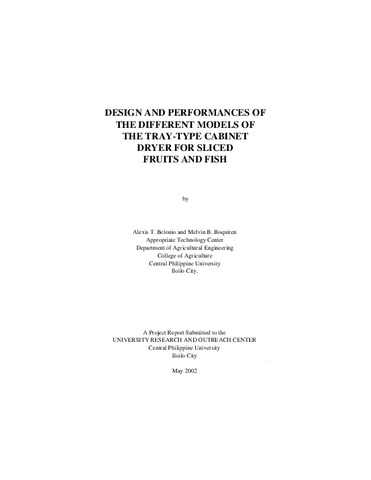Design and performances of the different models of the tray-type cabinet dryer for sliced fruits and fish
| dc.contributor.author | Boquiren, Melvin B. | |
| dc.contributor.author | Belonio, Alexis T. | |
| dc.date.accessioned | 2021-04-23T03:45:05Z | |
| dc.date.available | 2021-04-23T03:45:05Z | |
| dc.date.issued | 2002-05 | |
| dc.identifier.citation | Belonio, A. T. & Boquiren, M. B. (2002). Design and performances of the different models of the tray-type cabinet dryer for sliced fruits and fish (Research report). Jaro, Iloilo City : University Research Center, Central Philippine University. | en_US |
| dc.identifier.uri | https://hdl.handle.net/20.500.12852/793 | |
| dc.description | Abstract only | en_US |
| dc.description.abstract | Drying of perishable crops, such as sliced fruits and fish, is a major problem in the Philippines. This is especially true during the wet season where the traditional sun drying practice is difficult to accomplish due to unfavorable weather. Hence, resulting to low product quality and price. In 1999, the Appropriate Technology Center, Department of Agricultural Engineering, Central Philippine University, Iloilo City had designed and evaluated different models of the tray-type cabinet dryer. This project was initiated because of the demand by the processors for a drying equipment that could enable them to dry their products even if it is raining for days. The different models of the dryer designed include CFD-123, -245, -446, and -486, which use either electricity, LPG, or biomass as fuel. These dryers are made of a double-wall steel sheet and an angle bar with steel- screen-mesh trays as major materials. They vary in sizes and configuration in terms of the heat system and tray arrangement. All models were fabricated in small and medium-size shop in Lapaz, Iloilo City using local labor and skills. The dryers have a loading capacity ranging from 3 to 138 kg of fresh samples of the product per load depending on the model. Sliced fruits and fish can be dried in the dryer independent of the weather condition. Banana chips can be dried in the dryer within 4 to 10 hours depending on the thickness. Sliced mango can be dried within 12 to 18 hours while sliced camias and squash chips within 12 to 20 hours and 14 to 18 hours, respectively. Sweet potato and cassava can be dried shortly within 4 to 8 hours. A tank of LPG can be consumed in models CFD-245 and -446 dryer in drying the product at a rate of 2 to 8 loads, depending on the capacity of the dryer. For biomass-fed dryer, one-hour operation consumes about 1 sack of rice hull to sustain the required heat for drying. When using electricity, the smallest model (CFD-123) can consume a maximum of 200 watts for the entire operation. Labor requirement is minimal for the different models except for the biomass-fed dryer, which requires one person to attend the operation specifically in operating the furnace. The investment cost for the dryer per unit ranges from P15, 000 to P150, 000, depending on the size and model. Cost-return analysis showed that the cost to dry sliced mango ranges from P3.86 to P12.86 per kg. while for “tabagak” fish the drying cost ranges from P3.07 to P11.86 per kg. Return on investment ranges from 59% to 383% while the benefit-cost ratio ranges from 0.86 to 5.02 from the smallest (CFD-123) to the biggest (CFD486) model of the dryer, respectively. Payback period is 1.69 years for CFD-123 while only 0.26 year for CFD-486. | en_US |
| dc.format.extent | vi, 33 leaves | en_US |
| dc.language.iso | en | en_US |
| dc.subject.ddc | GSL 630. 72 B418d | en_US |
| dc.subject.lcsh | Dried fish | en_US |
| dc.subject.lcsh | Dried fruit | en_US |
| dc.subject.lcsh | Dried foods | en_US |
| dc.subject.lcsh | Food--Drying | en_US |
| dc.subject.lcsh | Drying apparatus | en_US |
| dc.subject.lcsh | Drying apparatus--Design and construction | en_US |
| dc.subject.lcsh | Food--Drying--Equipment and supplies | en |
| dc.title | Design and performances of the different models of the tray-type cabinet dryer for sliced fruits and fish | en_US |
| dc.type | Technical Report | en_US |
| dcterms.accessRights | Limited public access | en_US |
| dc.description.bibliographicalreferences | Includes bibliographical references | en_US |
Files in this item
This item appears in the following Collection(s)
-
Research reports [167]
-
Research reports [37]


